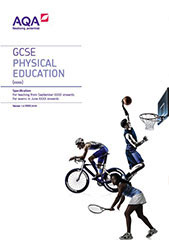3.1.1 Applied anatomy and physiology
Students should develop knowledge and understanding of the key body systems and how they impact on health, fitness and performance in physical activity and sport.
The structure and functions of the musculoskeletal system
Content |
Additional information |
|---|---|
Bones |
Identification of the bones at the following locations:
|
Structure of the skeleton |
How the skeletal system provides a framework for movement (in conjunction with the muscular system):
|
Functions of the skeleton |
Functions should be applied to performance in physical activity. |
Muscles of the body |
Identification of the following muscles within the body:
Students should be taught the role of tendons (attaching muscle to bones). |
Structure of a synovial joint |
Identification of the following structures of a synovial joint and how they help to prevent injury:
|
Types of freely movable joints that allow different movements |
Identification of the types of joints with reference to the following:
|
How joints differ in design to allow certain types of movement at a joint |
Understand that the following types of movement are linked to the appropriate joint type, which enables that movement to take place:
Application to specific sporting actions is in movement analysis. |
How the major muscles and muscle groups of the body work antagonistically on the major joints of the skeleton to affect movement in physical activity at the major movable joints |
With reference to the shoulder, elbow, hip, knee and ankle joints:
The difference between concentric and eccentric (isotonic) contractions. |
The structure and functions of the cardio-respiratory system
Content | Additional information |
|---|---|
The pathway of air | Identification of the pathway of air (limited to):
|
| Gaseous exchange | Gas exchange at the alveoli – features that assist in gaseous exchange:
Oxygen combines with haemoglobin in the red blood cells to form oxyhaemoglobin. Students should also know that haemoglobin can carry carbon dioxide. |
| Blood vessels | Structure of arteries, capillaries and veins:
How the structure of each blood vessel relates to the function:
Students should be taught the names of the arteries and the veins associated with blood entering and leaving the heart. |
| Structure of the heart | Structure of the heart:
|
| The cardiac cycle and the pathway of the blood | The order of the cardiac cycle, including diastole (filling) and systole (ejection) of the chambers. This starts from a specified chamber of the heart, eg the cardiac cycle starting at the right ventricle. Pathway of the blood:
Valve names are not required but students should be taught that valves open due to pressure and close to prevent backflow. |
Cardiac output, stroke volume and heart rate | Cardiac output, stroke volume and heart rate, and the relationship between them. Cardiac output (Q) = stroke volume x heart rate. Students should be taught how to interpret heart rate graphs, including an anticipatory rise, and changes in intensity. |
Mechanics of breathing – the interaction of the intercostal muscles, ribs and diaphragm in breathing | Inhaling (at rest) with reference to the roles of the:
Exhaling (at rest) with reference to the roles of the:
Lungs can expand more during exercise (inspiration) due to the use of pectorals and sternocleidomastoid. During exercise (expiration), the rib cage is pulled down quicker to force air out quicker due to use of the abdominal muscles. Changes in air pressure cause the inhalation and exhalation. |
Interpretation of a spirometer trace | Identification of the following volumes on a spirometer trace and an understanding of how these may change from rest to exercise:
Interpretation and explanation of a spirometer trace (and continue a trace on paper) to reflect the difference in a trace between rest and the onset of exercise. |
Anaerobic and aerobic exercise
Content |
Additional information |
|---|---|
Understanding the terms aerobic exercise (in the presence of oxygen) and anaerobic exercise (in the absence of enough oxygen) |
Definition of the terms:
Summary of aerobic exercise (glucose + oxygen → energy + carbon dioxide + water). Summary of anaerobic exercise (glucose → energy + lactic acid). |
The use of aerobic and anaerobic exercise in practical examples of differing intensities |
Link practical examples of sporting situations to aerobic or anaerobic exercise. Identification of the duration and/or intensity of a physical activity in order to identify and justify why it would be aerobic or anaerobic, eg marathon (aerobic), sprint (anaerobic). |
Excess post-exercise oxygen consumption (EPOC)/oxygen debt as the result of muscles respiring anaerobically during vigorous exercise and producing lactic acid |
Definition of the term EPOC (oxygen debt). An understanding that EPOC (oxygen debt) is caused by anaerobic exercise (producing lactic acid) and requires the performer to maintain increased breathing rate after exercise to repay the debt. |
The recovery process from vigorous exercise |
The following methods to recover from exercise, including the reasons for their use:
Students should be taught to evaluate the use of these methods, justifying their relevance to different sporting activities. |
The short and long term effects of exercise
Content |
Additional information |
|---|---|
Immediate effects of exercise (during exercise) |
|
Short-term effects of exercise (up to 36 hours after exercise) |
|
Long-term effects of exercise (months and years of exercising) |
Students should be taught the components of fitness to understand the long term effects of exercise. |
